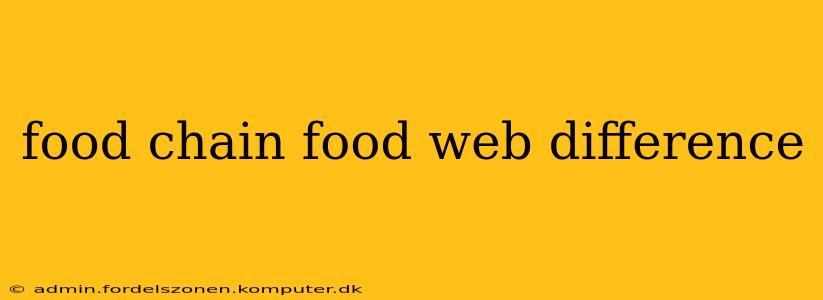Food Chain vs. Food Web: Understanding the Difference
The terms "food chain" and "food web" are often used interchangeably, but they represent distinct concepts in ecology. While both describe the flow of energy through an ecosystem, understanding their differences is crucial to grasping the complexity of nature's interconnectedness. This article will delve into the key distinctions between food chains and food webs, answering common questions along the way.
What is a Food Chain?
A food chain is a linear sequence illustrating the transfer of energy and nutrients from one organism to another. It typically starts with a producer (like a plant) that produces its own food through photosynthesis. This producer is then consumed by a primary consumer (herbivore), which in turn is eaten by a secondary consumer (carnivore), and so on. The chain ends with a top predator or apex predator, an organism with no natural predators. A simple example might be: grass → grasshopper → mouse → snake → hawk.
What is a Food Web?
A food web is a more complex and realistic representation of energy flow in an ecosystem. It's a network of interconnected food chains, showing the multiple feeding relationships between different organisms. Instead of a linear progression, a food web depicts a branching, interwoven structure where organisms can occupy multiple trophic levels (feeding levels) and may be part of several different food chains simultaneously. For example, a mouse might eat not only grass but also seeds, and it might be preyed upon by owls as well as snakes.
What are the key differences between a food chain and a food web?
The primary difference boils down to complexity and interconnectedness:
- Complexity: Food chains are simple and linear; food webs are complex and interconnected.
- Number of organisms: Food chains represent a single pathway of energy flow, involving fewer organisms. Food webs encompass multiple pathways and a larger number of organisms.
- Realism: Food chains offer a simplified model; food webs provide a more realistic portrayal of ecological interactions.
- Stability: Food webs are generally more stable than food chains because if one organism disappears, the impact is lessened due to alternative food sources and pathways.
How does a food chain differ from a food web in terms of energy flow?
Energy flow in a food chain follows a single, linear path. In contrast, energy flow in a food web is more intricate, branching out along various pathways. Energy is lost at each trophic level through respiration, heat, and waste. Food webs demonstrate how energy is distributed and shared across multiple organisms within an ecosystem.
Can a food chain exist without a food web?
No, a food chain cannot exist independently. A food chain is merely a simplified component of a food web. The food web is the encompassing system, and the food chain is just one possible linear sequence within that network.
What is the role of decomposers in a food chain and a food web?
Decomposers (like bacteria and fungi) play a vital role in both food chains and food webs. They break down dead organic matter, recycling essential nutrients back into the ecosystem, making them available for producers. They are essential for the overall balance and functioning of the entire system. While not explicitly shown in simplified food chain diagrams, they are implicitly part of the complete picture represented by the food web.
Why are food webs more useful than food chains for understanding ecosystems?
Food webs provide a far more comprehensive and realistic depiction of ecosystem dynamics. They illustrate the complexity of ecological interactions, showing the interconnectedness of various species and their responses to changes in the environment. Understanding food webs is crucial for conservation efforts, predicting ecological changes, and managing ecosystem health.
By grasping the distinctions between food chains and food webs, we gain a much deeper understanding of the intricate and dynamic relationships that underpin the functioning of all ecosystems.
